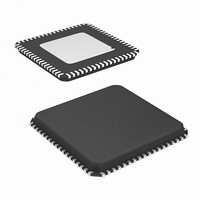ISL54105CRZ Intersil, ISL54105CRZ Datasheet - Page 13

ISL54105CRZ
Manufacturer Part Number
ISL54105CRZ
Description
IC TMDS REGENERATOR 72-QFN
Manufacturer
Intersil
Datasheet
1.ISL54105CRZ.pdf
(16 pages)
Specifications of ISL54105CRZ
Applications
Multimedia Displays, Test Equipment
Interface
I²C
Voltage - Supply
3 V ~ 3.6 V
Package / Case
72-VFQFN Exposed Pad
Mounting Type
Surface Mount
Operating Supply Voltage (typ)
3.3V
Operating Supply Voltage (min)
3V
Operating Supply Voltage (max)
3.6V
Operating Temp Range
0C to 70C
Operating Temperature Classification
Commercial
Mounting
Surface Mount
Lead Free Status / RoHS Status
Lead free / RoHS Compliant
Available stocks
Company
Part Number
Manufacturer
Quantity
Price
Part Number:
ISL54105CRZ
Manufacturer:
INTERSIL
Quantity:
20 000
ISL54105 Serial Communication
Overview
The ISL54105 uses a 2-wire serial bus for communication
with its host. SCL is the Serial Clock line, driven by the host
and SDA is the Serial Data line, which can be driven by all
devices on the bus. SDA is open drain to allow multiple
devices to share the same bus simultaneously.
Communication is accomplished in three steps:
1. The Host selects the ISL54105 it wishes to communicate
2. The Host writes the initial ISL54105 Configuration
3. The Host writes to or reads from the ISL54105’s
FIGURE 13. OPTIMAL (“T”) BYPASS CAPACITOR LAYOUT
with.
Register address it wishes to write to or read from.
Configuration Register. The ISL54105’s internal address
pointer auto increments, so to read registers 0x00
through 0x1B, for example, one would write 0x00 in step
2, then repeat step three 28 times, with each read
returning the next register value.
V
+
R
POWER
VIA TO
PLANE
VIA
C
R
EQUIVALENT CIRCUIT
BYPASS
TRACE
POWER PLANE
SDA
SCL
C
VIAS
GND
GROUND PLANE
TO
BYPASS
13
R
TRACE
V
GND
+
GND
V
IC
FIGURE 14. VALID START AND STOP CONDITIONS
+
IC
START
ISL54105
The ISL54105 has a 7-bit address on the serial bus,
determined by the ADDR0-ADDR6 bits. This allows up to
128 ISL54105s to be independently controlled by the same
serial bus.
The bus is nominally inactive, with SDA and SCL high.
Communication begins when the host issues a START
command by taking SDA low while SCL is high (Figure 14).
The ISL54105 continuously monitors the SDA and SCL lines
for the start condition and will not respond to any command
until this condition has been met. The host then transmits the
7-bit serial address plus a R/W bit, indicating if the next
transaction will be a Read (R/W = 1) or a Write (R/W = 0). If
the address transmitted matches that of any device on the
bus, that device must respond with an ACKNOWLEDGE
(Figure 15).
Once the serial address has been transmitted and
acknowledged, one or more bytes of information can be
written to or read from the slave. Communication with the
selected device in the selected direction (read or write) is
ended by a STOP command, where SDA rises while SCL is
high (Figure 14), or a second START command, which is
commonly used to reverse data direction without
relinquishing the bus.
Data on the serial bus must be valid for the entire time SCL
is high (Figure 16). To achieve this, data being written to the
ISL54105 is latched on a delayed version of the rising edge
of SCL. SCL is delayed and deglitched inside the ISL54105
for three crystal clock periods (120ns for a 25MHz crystal) to
eliminate spurious clock pulses that could disrupt serial
communication.
When the contents of the ISL54105 are being read, the SDA
line is updated after the falling edge of SCL, delayed and
deglitched in the same manner.
Configuration Register Write
Figure 17 shows two views of the steps necessary to write
one or more words to the Configuration Register.
Configuration Register Read
Figure 18 shows two views of the steps necessary to read
one or more words from the Configuration Register.
STOP
June 11, 2008
FN6723.0








